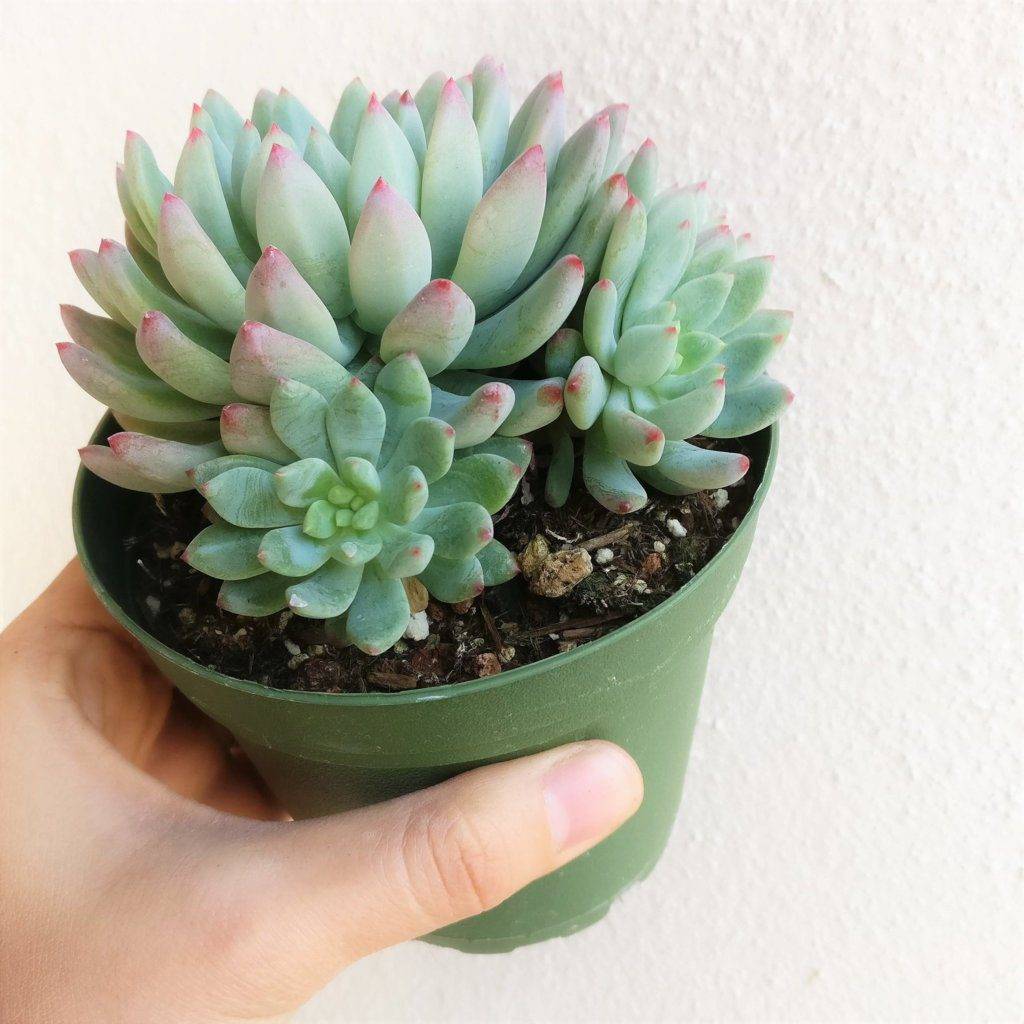Blue Elf Succulent – How to Grow and Care For Blue Elf Sedeveria Plants?
Hey folks! Welcome back!
You just need to take a glance at the happy plant(another name for Blue Elf Succulent) and you genuinely will feel happy, as the same happened to me when I saw its picture and came to know about it.
It is worth the hype because of its beautiful minimal appearance with all those pretty light pink edges. In this article, you can learn everything about the Blue Elf Succulent along with its growth and care tips.
Quick takeaways:
- This plant is a cross between sedum and echeveria.
- Leaf tips range in color from red to burgundy.
- Full sun is preferable to grow blue elf succulents. With blue elf succulents, they are available in many varieties like Tiger Jaws Succulent, Dolphin Succulent, Moonglow Succulent, Manfreda Succulent, Graptoveria Succulent, Little Jewel Succulent, etc.

What is a Blue Elf Succulent?
‘Blue Elf’ succulent, whose scientific name is xSedeveria ‘blue elf’ (called by people as Happy plant). It’s a lovely succulent with a thick coating of powdery farina and a blue-green rosette. For Sedeveria, this color change can be an indicator of direct sun stress, underwatering, or cold temperatures.
The name “Happy Plant” comes from the succulent’s lovely flowers. Sedeveria blooms only a few times a year, with lovely sunshine and yellow flowers that look extremely vibrant and nice.
Best conditions to grow Sedeveria-Blue Elf Succulent
- Full sun is preferable, Can be grown in the open air
- If this “happy plant” is overwatered, it can quickly die.
- Doesn’t like the cold conditions
- Prefers a temperature of -3.9°C (25°F) in Zones 9b-11b.
- Leaves, cuttings, or seeds are the best ways to propagate this plant.
How to Grow and Care for Blue Elf Succulent?
Sunlight needs
- Sunlight is needed by the plant so it means healthy, you have to provide bright indirect sunlight to the plant.
- To promote the healthy growth of the plant, you have to provide ample sunlight to the plant.
- If you’re growing it indoors, you can place it near the window where there is a good amount of bright indirect light.
- You can place them near the south-facing window or east-facing window as they will get sunlight from it.
- Keep in mind that you are not feeding much sunlight to the plant as it will harm the growth of the plant.
Watering needs
- You have to provide them with frequent watering, though they can grow well in less water.
- But it will help in stimulating the growth of the plant. So you have to do it.
- Keep in mind that you are not overwatering your plant as it is not good for the growth of the plant:
- Also, it is suggested that you have to water the plant when the soil of the plant becomes fully dry.
- You can check the moisture of the soil by inserting a finger inside the soil, so, if it is dry, then you can water the plant.
Soil and fertilizer needs
- This is one of the plants that requires well-drained and porous soil for the healthy growth of the plant.
- It will help in promoting a good flow of air in the plant and also the proper drainage.
- You can even as some of the organic matter to it like compost, perliet, cococoir, etc as it will help in providing nutrients to the plant.
- You can easily provide this plant with less fertilizer as excess supply will harm the growth of the plant.
- You can make use of a balanced and slow-release fertilizer. Feed them with once time in a month for good growth of the plant.
- You can apply fertilizer at the time of spring and summer season when the plant is growing actively in the garden area.
Temperature and humidity needs
- This succulent will grow well if you provide it with a good amount of average temperature that lies between 65°F and 80°F.
- The temperature should not go more than 90°F as it will cause issues in the plant and damage the health of the plant.
- This plant will grow well in the low level of humidity level. You can provide them with an average room humidity level.
- Also, if the humidity is too low, then you can make use of a humidifier to increase the level of humidity.
Potting and Repotting needs
- You have to repot this plant, it happens when the plant overgows and its roots coem out from the drainage holes.
- The new pot should consist of a good amount of drainage holes in it as it will help in ensuring proper drainage in the plant.
- You have to choose a new and fresh potting mix for your plant that should also contain peat etc.
- Also, you can probe the roots of the plant with the help of a shovel every week.
Pruning needs
- Last, but not least, this succulent is not too demanding when it comes to pruning this plant.
- You have to remove dead and damaged leaves from the plant which will help in stimulating new growth in the plant.
- You can even remove the offsets from the plant as it will help in providing more space for the parent plant to grow well.
- Keep in mind to use sharp and sterilized scissors for doing so as it will help in preventing the issues.
Few Growing tips for Blue Elf Succulent

- Planting Blue Elf Succulent in a fast-draining soil amended with perlite, pumice, or coarse sand is the first step.
- Bright light and limited watering
- Watering method for Blue Elf Succulent: It should not sit on the water, and an excess amount of water should be avoided. The best way of watering is to soak and dry this succulent method. Yet, the succulent should be controlled to avoid overwatering.
- Allow them to stay on the plant to add to the display, or carefully remove them to make room for more plants in other containers.
- keep in mind that it needs to be brought inside before frost, but it does benefit from the stress of cooler temperatures as summer progresses.
- When you get it inside, put it in bright light or the sun from a window.
Is propagation of Blue Elf Succulent possible?

- Blue Elf Succulent is a simple plant to grow. It can be propagated by separating offsets, but it can also be propagated by leaf cuttings and seeds if it is not a hybrid.
- You can simply place the plant where you want it to grow on the ground. It will quickly send out roots wherever the stems come into contact with the ground, as well as the root itself.
- You can cover the plant with a thin layer of soil to ensure that it starts growing where you put it.
- Blue Elf Succulent can also be propagated by breaking one of the stems and simply pushing it into the ground where you want it to grow. In a season or two, a new plant will be well established.
For more such plant related-articles, you may also read, What are Manfreda Succulents? – Types of Manfreda Plants – Growth and Care Tips
Dying succulents
While dead leaves near the bottom of your succulent are perfectly healthy, dead leaves near the tops of new growth indicate a problem usually due to over- or under-watering.
Overwatering is likely the cause of your plant’s leaves turning yellow and transparent, as well as feeling soggy or mushy to the touch.
Common problems with Blue Elf Succulents
Caring for your plant is important, but various problems are being faced by the plant so you have to be aware of such problems so that you can find the solutions to prevent them. They are as follows:
Oversupply of water
Are you feeding the right amount of water to your plants? Excess supply of water will cause root rot in the plant which is not a healthy practice in the plant.
so it is suggested to let the soil dry fully, Then only you have to water the plant. Keep in mind that you give a gap between waterings.
Less supply of water
If you feed a low water supply to the plant, then the plant will not survive for long. Though It is a drought-tolerant plant it also requires water to produce bushy foliage in the plant.
You have to only water the plant when the soil is dry and you have to check the moisture by putting your finger inside the soil and if it feels dry then only you have to water.
Sunburn
is another issue that is faced by this plant because of the excess supply of sunlight to the plants. Especially in the summer season, the leaves get burned because of the excess supply of sunlight to the plants.
It will cause brown and coloured patches on the leaves which will let you know that the plant is suffering from some issue. So you have to keep in mind to provide your plant with a good amount of bright but indirect light.
Pest infestation
As you know pests tend to come to the plant to ruin its foliage, the same is the case with this succulent. Some of the pests like mealybugs, aphids, and spider mites tend to come to the plant to suck its fluid from the plant and attain energy from the plant.
You can see them with signs like residue in the plant, webs, etc. So, you have to prevent the pests from the plant by making use of neem oil or any insecticidal soap.
Wrapping up the Context
In this guide, you come to know that ‘Blue Elf’ succulent, whose scientific name is xSedeveria ‘blue elf’ (called by people as Happy plant). It’s a lovely succulent with a thick coating of powdery farina and a blue-green rosette. For Sedeveria, this color change can be an indicator of direct sun stress, underwatering, or cold temperatures. I hope you are done with the guide.
Thanks for reading! Happy Gardening!
FAQ‘s
How often do you water a Blue Elf Sedeveria?
Wait until the soil is completely dry before watering again. You could also simply wait until the Sedeveria leaves start to shrivel up.
How can I tell if my Blue Elf Succulent is in good health?
Succulents with vibrant colours, firm leaves, and slow growth are healthy. Dried leaves may also be found at the bottom of your succulent on occasion, but this is a good sign.
How do I know if my Blue Elf Succulent needs water?
The leaves look wrinkled and shriveled, indicating that it needs more water.
How do you protect your blue elf plant from getting rotten?
To avoid rot, they require bright sunlight, good drainage, and infrequent watering. Use well-draining cactus and succulent soil with 50 percent to 70 percent mineral grit, such as coarse sand, pumice, or perlite, in containers with drainage holes.


